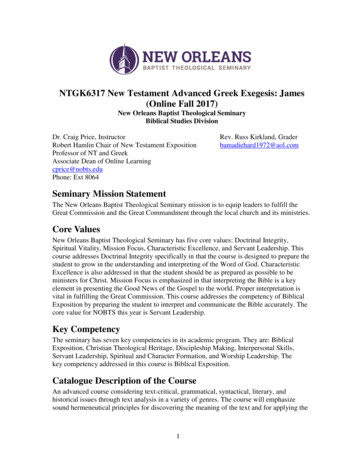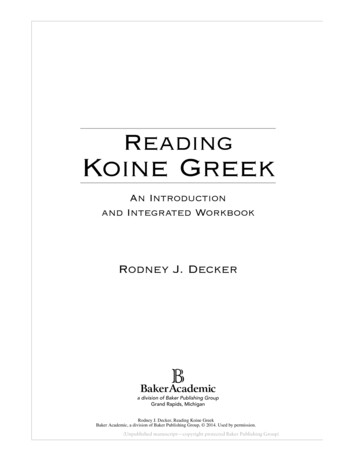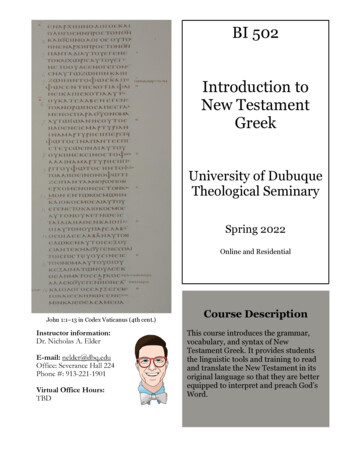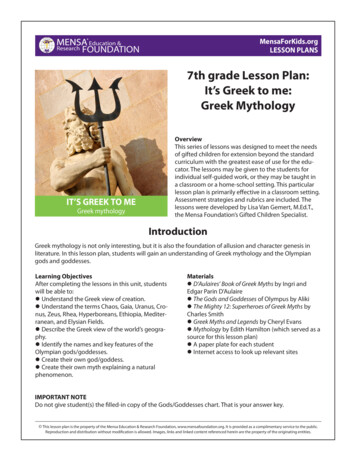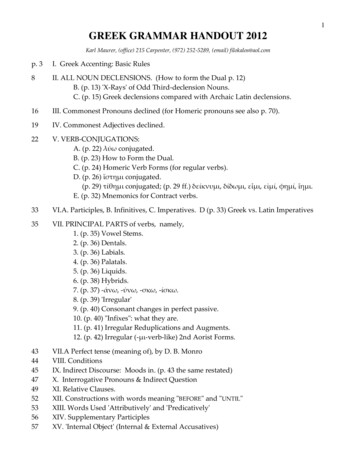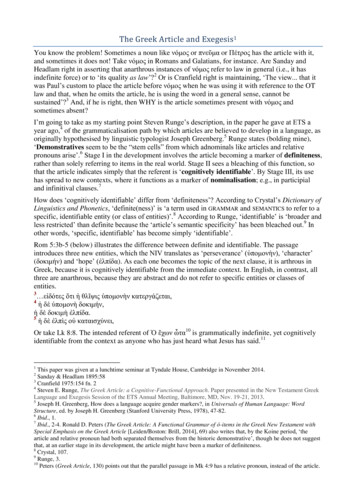
Transcription
The Greek Article and Exegesis1You know the problem! Sometimes a noun like νόμος or πνεῦμα or Πέτρος has the article with it,and sometimes it does not! Take νόμος in Romans and Galatians, for instance. Are Sanday andHeadlam right in asserting that anarthrous instances of νόμος refer to law in general (i.e., it hasindefinite force) or to ‘its quality as law’?2 Or is Cranfield right is maintaining, ‘The view. that itwas Paul’s custom to place the article before νόμος when he was using it with reference to the OTlaw and that, when he omits the article, he is using the word in a general sense, cannot besustained’?3 And, if he is right, then WHY is the article sometimes present with νόμος andsometimes absent?I’m going to take as my starting point Steven Runge’s description, in the paper he gave at ETS ayear ago,4 of the grammaticalisation path by which articles are believed to develop in a language, asoriginally hypothesised by linguistic typologist Joseph Greenberg.5 Runge states (bolding mine),‘Demonstratives seem to be the “stem cells” from which adnominals like articles and relativepronouns arise’.6 Stage I in the development involves the article becoming a marker of definiteness,rather than solely referring to items in the real world. Stage II sees a bleaching of this function, sothat the article indicates simply that the referent is ‘cognitively identifiable’. By Stage III, its usehas spread to new contexts, where it functions as a marker of nominalisation; e.g., in participialand infinitival clauses.7How does ‘cognitively identifiable’ differ from ‘definiteness’? According to Crystal’s Dictionary ofLinguistics and Phonetics, ‘definite(ness)’ is ‘a term used in GRAMMAR and SEMANTICS to refer to aspecific, identifiable entity (or class of entities)’.8 According to Runge, ‘identifiable’ is ‘broader andless restricted’ than definite because the ‘article’s semantic specificity’ has been bleached out.9 Inother words, ‘specific, identifiable’ has become simply ‘identifiable’.Rom 5:3b-5 (below) illustrates the difference between definite and identifiable. The passageintroduces three new entities, which the NIV translates as ‘perseverance’ (ὑπομονὴν), ‘character’(δοκιμήν) and ‘hope’ (ἐλπίδα). As each one becomes the topic of the next clause, it is arthrous inGreek, because it is cognitively identifiable from the immediate context. In English, in contrast, allthree are anarthrous, because they are abstract and do not refer to specific entities or classes ofentities.3 εἰδότες ὅτι ἡ θλῖψις ὑπομονὴν κατεργάζεται,4ἡ δὲ ὑπομονὴ δοκιμήν,ἡ δὲ δοκιμὴ ἐλπίδα.5ἡ δὲ ἐλπὶς οὐ καταισχύνει,Or take Lk 8:8. The intended referent of Ὁ ἔχων ὦτα10 is grammatically indefinite, yet cognitivelyidentifiable from the context as anyone who has just heard what Jesus has said.111This paper was given at a lunchtime seminar at Tyndale House, Cambridge in November 2014.Sanday & Headlam 1895:583Cranfield 1975:154 fn. 24Steven E. Runge, The Greek Article: a Cognitive-Functional Approach. Paper presented in the New Testament GreekLanguage and Exegesis Session of the ETS Annual Meeting, Baltimore, MD, Nov. 19-21, 2013.5Joseph H. Greenberg, How does a language acquire gender markers?, in Universals of Human Language: WordStructure, ed. by Joseph H. Greenberg (Stanford University Press, 1978), 47-82.6Ibid., 1.7Ibid., 2-4. Ronald D. Peters (The Greek Article: A Functional Grammar of ὁ-items in the Greek New Testament withSpecial Emphasis on the Greek Article [Leiden/Boston: Brill, 2014], 69) also writes that, by the Koine period, ‘thearticle and relative pronoun had both separated themselves from the historic demonstrative’, though he does not suggestthat, at an earlier stage in its development, the article might have been a marker of definiteness.8Crystal, 107.9Runge, 3.10Peters (Greek Article, 130) points out that the parallel passage in Mk 4:9 has a relative pronoun, instead of the article.2
Last year saw the publication of a couple of doctoral dissertations on the Greek article: StephenJanssen’s The Greek Article in Pauline Literature: Traditional Grammar and Discourse Perspectives at Dallas Theological Seminary12 and Ronald D. Peters’ The Greek Article: A FunctionalGrammar of ὁ-items in the Greek New Testament with Special Emphasis on the Greek Article atMcMaster University.13 They are in agreement that the presence of the article has to do withcognitive identifiability, rather than definiteness, so I will take it as a given that the presence of anarticle in Greek informs the reader that the entity is cognitively identifiable.Let’s see what this means by comparing how three NT books begin. 1 Peter is typical of epistleswhere the author makes no assumptions about what the readers can already identify. We can seethis because the opening verses (1-2) contain not a single article:14 Πέτρος ἀπόστολος ἸησοῦΧριστοῦ ἐκλεκτοῖς παρεπιδήμοις διασπορᾶς Πόντου, Γαλατίας, Καππαδοκίας, Ἀσίας καὶ Βιθυνίας,κατὰ πρόγνωσιν θεοῦ πατρὸς ἐν ἁγιασμῷ πνεύματος εἰς ὑπακοὴν καὶ ῥαντισμὸν αἵματος ἸησοῦΧριστοῦ. Note especially Peter’s anarthrous references to God the Father (θεοῦ πατρὸς) and to theHoly Spirit (ἐν ἁγιασμῷ πνεύματος). (Because all eight of the references to Jesus Christ in 1 Peterare anarthrous, I will not assert anything about the anarthrous nature of that expression—no choice,no meaning!15.)Peter’s approach, then, is to make no assumptions as to what is already in his readers’ minds.Once he has activated an entity such as ‘God’, though, further references are cognitivelyidentifiable, so can be arthrous (e.g., ὁ θεὸς —3; τὸ ἐν αὐτοῖς πνεῦμα Χριστοῦ—11).Contrast the opening of 1 Peter with the opening of 1 Thessalonians: Παῦλος καὶ Σιλουανὸς καὶΤιμόθεος τῇ ἐκκλησίᾳ Θεσσαλονικέων ἐν θεῷ πατρὶ καὶ κυρίῳ Ἰησοῦ Χριστῷ. The introductoryreference to God the Father is again anarthrous, but the reference to the church of (the)Thessalonians is not. This indicates that the entity is cognitively identifiable both to Paul and his coauthors (it is not long since they were in Thessalonia), and to the original readers (they can envisagethe gathering of Thessalonians as something that is happening when the letter is to be read, soidentifiable, as far as they are concerned.)Notice that Paul did not write τῇ ἐκκλησίᾳ τῶν Θεσσαλονικέων. This is because he cannotspeak of them as an identifiable group. Most of the believers who were already meeting togetherwhen he left Thessalonica will hopefully be present when the letter was read, but probably not all,and in the Grace of God, a lot more Thessalonians will have been added to the group, too.Now let’s go to Luke 1:1: Ἐπειδήπερ πολλοὶ ἐπεχείρησαν ἀνατάξασθαι διήγησιν περὶ τῶνπεπληροφορημένων ἐν ἡμῖν πραγμάτων. The presence of the article indicates that Luke expectsTheopholous to be able to identify the referent of ‘the things that have been fulfilled among us’.How is the recipient of such documents to identify the referents that the writer has in mind?Linguist Knud Lambrecht offers a list of means of identification that includes anaphora and encyclopaedic knowledge, among others.16 Readers of 1 Pe 1:11 can identify the referent of τὸ ἐν αὐτοῖςπνεῦμα Χριστοῦ through anaphora (the reference in v 2 to the Spirit [ἐν ἁγιασμῷ πνεύματος]). Incontrast, Theopholus is expected to identify the referent of περὶ τῶν πεπληροφορημένων ἐν ἡμῖνπραγμάτων (Lk 1:1) from his encyclopaedic knowledge.Anaphora underlies the default rule that Heimerdinger and Levinsohn proposed for references byname to participants; viz., that activating references are anarthrous, whereas further references are11‘By it the hearers are summoned to hear at a deeper level than mere sense perception’ (I. Howard Marshall, TheGospel of Luke: A Commentary on the Greek Text [Exeter: Paternoster Press, 1978], 320).12Stephen Janssen, The Greek Article in Pauline Literature: Traditional Grammar and Discourse Perspectives (Dallas:Dallas Theological Seminary, 2013).13Peters, Greek Article.14**Comment on whether this is the norm also for salutations in secular letters of the period.**15Levinsohn, Narrative, §0.2.1.16Knud Lambrecht, Information Structure and Sentence Form: Topic, Focus, and the Mental Representations ofDiscourse Referents (Cambridge: Cambridge University Press, 1994), 87-92.
arthrous.17 The same principle can be proposed as a default rule for all entities: Activatingreferences to entities are anarthrous, whereas further references are arthrous.In his discussion of how the referent of anarthrous expression is identified, Runge makes adistinction between the prototypical function of the article with ‘identifiable noun phrases’ and lessprototypical uses with nominalised forms such as infinitives and participles.18 Such ‘non-nominal’entities are still cognitively identifiable, but are ‘less likely to have a discourse anaphor’. 19 Rather,their identifiability is ‘more likely to derive from encyclopedic knowledge or pragmaticbootstrapping’.20Runge’s observation is helpful for explaining why the article is present in Mt 13:3 (ἰδοὺ ἐξῆλθενὁ σπείρων τοῦ σπείρειν)—the words with which Jesus begins some teaching. ὁ σπείρων isparticipial, and its identifiability derives not from an a prior reference to a sower, but from theencyclopaedic knowledge shared by Jesus and his audience as to the existence of sowers and of howsowers of that period sowed their seed.21Anarthrous references to identifiable entitiesIf the presence of the article indicates that the referent is identifiable, what does its absence mean?It is often the case, of course, that the referent is not yet identifiable, as was the case with ὑπομονὴνand δοκιμήν in Rom 5:3-4 (the last reference to ὑπομονή was in 2:7, in a very different context;there is no previous reference to δοκιμή; ἐλπίς, in contrast was last mentioned just two versesearlier). But why, when Peter and Cornelius are conversing in Acts 10, does the reference to Peterchange from being arthrous in v 26 (ὁ Πέτρος) to being anarthrous in v 34 (Ἀνοίξας δὲ Πέτρος τὸστόμα εἶπεν)?Such examples of anarthrous references by name to active participants (and there are many inActs),22 suggest, in the first instance, that we are dealing with an unmarked-marked pair, with thearticle as the marked member of the pair: Identifiable. This allows us to claim that, whereasentities with the article such as ὁ Πέτρος are Identifiable, the absence of the article (Πέτρος) doesNOT mean that the referent is not identifiable.23I said earlier that, in their dissertations, Peters and Janssen are in agreement that the article is Identifiable. Where they are in total disagreement is over the significance of the absence of thearticle when the referent is clearly identifiable, as is the case in Acts 10:34.Because the Greek article is the marked member of a ‘privative opposition’,24 the Porter school tends toassign prominence to that member,25 and that is precisely what Peters does. In particular, the article for himis both Identifiable and Salient.2617Heimerdinger & Levinsohn, Article before names, 18; Levinsohn, Discourse Features, §9.2.1.Runge, Cognitive-Functional Approach, 7, 9.19Ibid., 9, 10.20Ibid., 10.21‘the tale Jesus narrates seems quite ordinary as it provides the beginning, middle, and end of the yearly cycleexperienced by farmers’ (Joel B. Green, The Gospel of Luke. The New International Commentary on the New Testament[Grand Rapids MI: Eerdmans, 1997], 324).22See Heimerdinger & Levinsohn23‘when a certain marker is present, the feature implied by the marker is present. However, when the marker is absent,nothing is said about the presence or absence of the feature—the sentence is unmarked for that feature. In other words,it is not necessarily true that the function of the unmarked form is the opposite of that of the marked form.’ (Stephen H.Levinsohn, Discourse Features of New Testament Greek: A Coursebook on its Information Structure and other devices,2nd ed. [Dallas: SIL International, 2000], ix).24David Crystal, A Dictionary of Linguistics and Phonetics. 3rd. ed. (Oxford: Basil Blackwell, 1991), 307.25‘Markedness is one of the most important means by which prominence is established for a given element’ (Stanley E.Porter, Prominence: A theoretical overview. In Stanley E. Porter and Matthew Brook O’Donnell (eds.), The Linguist asPedagogue: Trends in the Teaching and Linguistic Analysis of the Greek New Testament [Sheffield: Sheffield PhoenixPress, 2009], 56).26Peters, Greek Article, 272.18
The first thing to point out is that such a claim is linguistically suspect, because linguists do not expect twofeatures to distinguish the members of a closed set with only two members. Rather, one characteristic ofnatural languages is underspecification.27Secondly, Runge demonstrates that Porter has confused symmetrical and asymmetrical markednessand ‘derives a symmetrical theoretical framework of markedness from their asymmetrical claims’.28This means that, although the presence versus absence of the article may be understood as aprivative opposition, it does not follow that the marked member will be more prominent than theunmarked member.Unfortunately, Peters does not discuss the absence of the article in Ac 10:34, but I do not see howhe could maintain that the apostle Peter is suddenly less salient than he was earlier in his conversation with Cornelius. Rather, I would maintain that Heimerdinger and I were correct in maintainingthat ‘Such references appear to have the rhetorical effect of highlighting that speech’. When thespeech concerned is ‘a response by the address of the last speech, references to the speaker aretypically anarthrous only if the speech is the climax of the episode or otherwise is of particularimportance.’29One more example to drive my point home, from Acts 15:39-40 (below). All four of the participantshave been mentioned in recent verses: Silas in 32 and the other three in 38. The references to thetwo participants who feature in 39 are arthrous (Barnabas and Mark), while the references to thethose who feature in 40 (Paul and Silas) are anarthrous. I write (bolding added), ‘Of particular noteis the articular reference to Barnabas in Ac. 15:39b, at the point that he ceases to be salient to thebook because he leaves the scene’.3039ἐγένετο δὲ παροξυσμὸςὥστε ἀποχωρισθῆναι αὐτοὺς ἀπ’ ἀλλήλων,τόν τε Βαρναβᾶν παραλαβόντα τὸν Μᾶρκον ἐκπλεῦσαι εἰς Κύπρον,40Παῦλος δὲ ἐπιλεξάμενος Σιλᾶν ἐξῆλθεν παραδοθεὶς τῇ χάριτι τοῦ κυρίου ὑπὸ τῶν ἀδελφῶνThe claim that anarthrous references to identifiable entities give prominence to their referent appliesnot only to named participants, but also to other nouns. The following material closely follows theargument in §9.3 of Discourse Features.The references in Galatians to God (θεός) illustrate how this works. Once God the Father has beenactivated anarthrously in 1:1 (θεοῦ πατρὸς), θεός is usually articular in the first three chapters of theletter since the references to God are not the focal constituents of the clause or sentence concerned.Rather, they are supportive of the focal constituents. For example, in 3:11a (ὅτι δὲ ἐν νόμῷ οὐδεὶςδικαιοῦται παρὰ τῷ θεῷ δῆλον ‘Now it is evident that no man is justified before God by the law’—NRSV), the focal constituents are ‘no man’ (οὐδείς) and ‘evident’ (δῆλον) 31 If read orally, withthe context taken into account, stress will fall on some or all of these constituents, but not on ‘beforeGod’ (παρὰ τῷ θεῷ).32Contrast 2:19b (ἐγὼ γὰρ διὰ νόμου νόμῳ ἀπέθανον, ἵνα θεῷ ζήσω), where anarthrous θεῷ iscontrasted with νόμῳ, as it is focal and central to the argument.3327See Johan Rooryck, On two types of underspecification: Towards a feature theory shared by syntax and phonology.Phobus 6 (1994), 208.28‘Asymmetrical markedness organizes sets of data based on the presence or absence of certain qualities, i.e. linguisticfeatures. Symmetrical markedness ranks a set based on the quantity of a particular shared feature, e.g. semantic weightor prominence.’ (Steven E. Runge, The Perfect, Markedness, and Grounding [Paper presented in the Biblical GreekLanguage and Linguistic Session of the SBL Annual Meeting, Baltimore, MD, Nov. 22-25, 2013], 24-25.29Levinsohn, Discourse Features, §9.2.3.30Levinsohn, Discourse Features, §9.2.3. The anarthrous references to Paul and Barnabas in vv 36-38 signal ‘switchesof attention from one salient participant to another within the same scene’ (ibid.).31See Levinsohn, Discourse Features, §9.4 for discussion of why ἐν νόμῳ is anarthrous.32See also Gal 2:21 and 3:18.33Similarly, in Gal 4:8-9, in which discussion centers on ‘knowing God’ and ‘being known by God’, the references toGod are anarthrous. See also Gal 4:14 and 6:7. In Ephesians, references to God as an active participant are anarthrousonly when the constituent concerned is preposed for focal prominence (2:8, 4:24) or otherwise is especially prominent
References to the Holy Spirit in Gal 3:2b (ἐξ ἔργων νόμου τὸ πνεῦμα ἐλάβετε ἢ ἐξ ἀκοῆςπίστεως;—articular) and 3:3b (ἐναρξάμενοι πνεύματι νῦν σαρκὶ ἐπιτελεῖσθε;—anarthrous) illustratethe operation of the same principle. In 2b, it is not necessary to argue that the reference is to theperson rather than the power of the Holy Spirit.34 Rather, the reference to the Spirit is supportive,because the focus of the sentence is the contrast between ‘by works of law’ and ‘by hearing withfaith’, with ‘you received the Spirit by some means’ as the presupposition. In 3b, however, thecontrast between ‘in the Spirit’ and ‘in the flesh’ is focal and central.See also the references to the Holy Spirit in Ac. 8:17-18 (below). In 17b, it is anarthrous, asbefits focal constituents. In 18, however, τὸ πνεῦμα is the propositional topic about which acomment is made and the reference is articular.3517τότε ἐπετίθεσαν τὰς χεῖρας ἐπ’ αὐτοὺς καὶ ἐλάμβανον πνεῦμα ἅγιον.18ἰδὼν δὲ ὁ Σίμωνὅτι διὰ τῆς ἐπιθέσεως τῶν χειρῶν τῶν ἀποστόλων δίδοται τὸ πνεῦμα Janssen’s dissertation takes up the claim that anarthrous references to identifiable entities giveprominence to their referent and applies it to the whole Pauline corpus.The tendency for propositional topics to be arthrous, and for prominent focal constituents to beanarthrous, is consistent with Wallace’s comment about predicate nominatives, ‘Generallyspeaking, the subject will be distinguished from the predicate nominative by having the article’.36 Itis consistent also with Colwell’s rule,which reads as follows, ‘Definite predicate nouns whichprecede the verb usually lack the article a predicate nominative which precedes the verb cannotbe translated as an indefinite or a ‘qualitative’ noun solely because of the absence of the article; ifthe context suggests that the predicate is definite, it should be translated as a definite noun ’37You may remember that Colwell cited the preferred UBS reading of Jn 1:49 (Ῥαββί, σὺ εἶ ὁ υἱὸςτοῦ θεοῦ, σὺ βασιλεὺς εἶ τοῦ Ἰσραήλ) in support of his claim. The articular variant (σὺ εἶ ὁβασιλεὺς τοῦ Ἰσραήλ) suggests that βασιλεὺς τοῦ Ἰσραήλ is active and identifiable (probablyrelating back to Phillip’s reference to Jesus in 45 as Ὃν ἔγραψεν Μωϋσῆς ἐν τῷ νόμῳ καὶ οἱπροφῆται).Grammarians have long recognised that the preposing of focal constituents ‘emphasises’ them (i.e.,gives them prominence).38 It seems, then, that Greek writers have the option of making focal constituents doubly prominent. First, placing a focal constituent such as βασιλεὺς before the verb gives itprominence. If, in addition, the entity concerned is active and identifiable, then the omission of thearticle adds to that prominence.39Application to 1 PeterSince Mark Dubis and I are in the process of writing a paper on the presence versus absence of thearticle in 1 Peter, I will now concentrate on the presence versus absence of the article in differentconstructions in that book. Of particular interest will be arthrous references to entities that have notfeatured previously in the letter, the use of the article with participles and the τοῦ infinitiveconstruction.With nouns and noun phrasesLet me start, though, by discussing the significance of the presence versus absence of the articlewith reference to the eight instances of πνεῦμα in 1 Peter, as they illustrate the introduction of an(6:17). (The anarthrous reference to God in 6:23 may be formulaic.) When a focal reference to God is post-verbal, thereference is articular (3:9, 3:10, 5:20).34See Francis 1985:136-37, Swartz 1993.35For further discussion of anarthrous references to the Holy Spirit, see Levinsohn 1993.36Wallace, 242. Wallace (p. 243) cites Mt 12:8; Jn 1:1, 5:18; Phil 1:8, 2:6; 1 Tim 6:5; Jas 5:10 and 1 Jn 4:14.37E. C. Colwell, A definite rule for the use of the article in the Greek New Testament, JBL 52 (1933), 20.38See, for example, BDF §472(2).39See also Alford’s comment, ‘Emphatic position will often dispense with the art.’ (Alford, IV.4) though, in fact,Alford was referring to ἐν υἱῷ in Heb 1:1, which is in its normal post-verbal position at the end of the clause.
entity without the article (1:2), the presence of the article to indicate that the entity can be related tosomething in the context and is cognitively identifiable (1:11, 3:4, 3:19, 4:14), and the absence ofthe article when the entity is focally prominent (1:12, 3:18, 4:6). I discuss each reference in turn.As already noted, the introductory reference to the Holy Spirit is anarthrous (κατὰ πρόγνωσιν θεοῦπατρὸς ἐν ἁγιασμῷ πνεύματος—1:2).The second instance of πνεῦμα is found in 1:11 (εἰς τίνα ἢ ποῖον καιρὸν ἐδήλου τὸ ἐν αὐτοῖςπνεῦμα Χριστοῦ) and is arthrous; τὸ ἐν αὐτοῖς πνεῦμα Χριστοῦ is the topic of the clause. The sameis true of the final reference, in 4:14 (ὅτι τὸ τῆς δόξης καὶ τὸ τοῦ θεοῦ πνεῦμα ἐφ’ ὑμᾶςἀναπαύεται).The reference in 1:12 is anarthrous (ἃ νῦν ἀνηγγέλη ὑμῖν διὰ τῶν εὐαγγελισαμένων ὑμᾶς [ἐν]πνεύματι ἁγίῳ ἀποσταλέντι ἀπ’ οὐρανοῦ). If we assume, with Davids, that ‘the same Spirit whoinspired the prophets has been sent from heaven to inspire the messengers’,40 then the absence ofthe article gives focal prominence to ‘by the Holy Spirit sent from heaven’.41The arthrous reference in 3:4 (ἀλλ’ ὁ κρυπτὸς τῆς καρδίας ἄνθρωπος ἐν τῷ ἀφθάρτῳ τοῦ πραέωςκαὶ ἡσυχίου πνεύματος) is not to the Holy Spirit, but to ‘the character of the human spirit or thehuman spirit as influenced by God’s grace’.42 The entity is identifiable by relating it to something inthe context, such as ‘the purity and reverence’ of the lives of the wives (v 2).This brings us to 3:18-19 (θανατωθεὶς μὲν σαρκὶ / ζῳοποιηθεὶς δὲ πνεύματι ἐν ᾧ καὶ τοῖς ἐνφυλακῇ πνεύμασιν πορευθεὶς). I start with the four common interpretations that Mark Dubisconsiders.431. ‘Patristic interpreters commonly viewed these nouns as referring to the body and the spirit ofJesus’.44 Dubis rejects this interpretation because it ‘suggests that Jesus’ spirit was at some point“dead,” an unthinkable notion within the broader confines of NT theology’.452. The nouns σαρκὶ and πνεύματι ‘refer to two modes or spheres of existence, not constituent partsof Jesus’. Clowney writes, ‘Peter is not saying that Christ’s body died but that his spiritcontinued to live. He is saying that Christ died as to the natural, physical sphere of existence,and that Christ was given life as to the spiritual sphere of existence.’46 ‘Thus, the second phrasedoes not refer to Christ disembodied, but to Christ risen to life on a new plane’.47 Barclay’stranslation ‘in his spirit’ reflects this position.3. Dubis rejects Achtemier’s interpretation of both nouns as datives of instrument or agency: Jesuswas ‘put to death by humans, but made alive by the Spirit’.4. Instead, he understands θανατωθεὶς σαρκὶ to refer to the bodily death of Jesus (‘in thebody’—NIV), while ‘ζῳοποιηθεὶς πνεύματι is best understood as a reference to Jesus’resurrection, with the most natural interpretation of πνεύματι being a dative of agency’48 (‘bythe Spirit’—NIV).40Peter H. Davids, The First Epistle of Peter. The New International Commentary on the New Testament (GrandRapids: Eerdmans, 1990), 64.41However, A. J. Mason (The First Epistle of St. Peter. A Bible Commentary for English Readers. Vol. VIII Ephesiansto Revelation, ed. by Charles John Ellicott [London/Paris/New York/Melbourne: Cassell & Co. Ltd., n.d.], **) considersthat Peter does not wish the readers to identify ‘the full effusion of the Spirit now, with His limited working in theprophets’.42Davids, First Epistle of Peter, 119.43Mark Dubis, 1 Peter: A Handbook on the Greek Text (Baylor University Press, 2010), 118.44Dubis, 1 Peter, 117.45Ibid.46Edmund P. Clowney, The Message of Peter. The Bible Speaks Today (Leicester: Inter-Varsity Press, 1988), 158.47R. T. France, Exegesis in practice: two examples, in New Testament Interpretations: Essays on Principles andMethods, ed. by I. H. Marshall (Grand Rapids: Eerdmans, 1977), 267.48Dubis, 1 Peter, 118.
The first thing I must say is that, because πνεύματι is focally prominent, contrasting with σαρκὶ inthe previous clause, the potential is there for the entity is cognitively identifiable. So, the anarthrousnature of πνεύματι presents no problem for either ‘in his spirit’ (Barclay) or ‘by the Spirit’ (NIV).There is another factor to take into consideration, though, and that is the arthrous reference to ‘thespirits in prison’ in 3:19 (ἐν ᾧ καὶ τοῖς ἐν φυλακῇ πνεύμασιν πορευθεὶς). Since these spirits havenot previously been mentioned, the presence of the article indicates that the entity is identifiable.Given that πνεύματι occurs in the immediate context, it would be most natural to relate ‘the spiritsin prison’ to πνεύματι. This leads me to favour the second interpretation and take πνεύματι to mean‘in the sphere of “the spirit”’,49 as such an interpretation makes ‘the spirits in prison’ accessible, inline with the extra-Biblical Jewish literature of the time.50Although most nouns in 1 Peter behave like πνεῦμα when it comes to the presence versus absenceof the article, Χριστός does not. The combination Ἰησοῦς Χριστός is always anarthrous,51 andΧριστός by itself is only arthrous in three times. So, the norm is for Χριστός to be anarthrous evenwhen it is the topic of a clause, as in the genitive absolute Χριστοῦ οὖν παθόντος σαρκὶ (4:1a). It isalso anarthrous within an arthrous phrase, as in τὸ ἐν αὐτοῖς πνεῦμα Χριστοῦ (1:11). Why, then, is itarthrous on three occasions? What is the effect, in these passages, of indicating that the reference toChrist is identifiable and to be related to something in the context?κύριον δὲ τὸν Χριστὸν ἁγιάσατε ἐν ταῖς καρδίαις ὑμῶν (3:15) is an adaptation of Is 8:13 (LXX),with τὸν Χριστὸν replacing αὐτὸν. Although Χριστὸν is not an adjective, we may think of it asbeing in Wallace’s ‘third attributive position’.52 Peters argues for a close relation between the articleand the relative pronoun,53 and this is one place where that insight is particularly helpful, as Peter’sdesire is to identify the κύριον of the quote from Isaiah as the Messiah. In other words, the sense ofκύριον τὸν Χριστὸν is ‘[the] Lord who is the Christ’.54The motivation for the presence of the article in 4:13 (τοῖς τοῦ Χριστοῦ παθήμασιν) and 5:1 (ὁσυμπρεσβύτερος καὶ μάρτυς τῶν τοῦ Χριστοῦ παθημάτων) is different. In both passages, a contrastis being made between Christ’s sufferings and his glory (e.g. ἵνα καὶ ἐν τῇ ἀποκαλύψει τῆς δόξηςαὐτοῦ χαρῆτε—4:13). In most NT books, the norm is for genitival modifiers to follow their headnoun.55 Placing it before the noun ‘gives it greater prominence’.56 For example,, τοῖς Χριστοῦπαθήμασιν (with Χριστοῦ anarthrous) would have given greater prominence to Χριστοῦ. Thepragmatic effect of making the reference arthrous is to direct attention more to the head nounitself.57Contrast 1:11 (προμαρτυρόμενον τὰ εἰς Χριστὸν παθήματα καὶ τὰς μετὰ ταῦτα δόξας). This is the49Francis Wright Beare, The First Epistle of Peter, The Greek Text with Introduction and Notes (Oxford: BasilBlackwell, 1947), 169.50See, for example, chapter 7 (‘Light from the book of Enoch’) of William J. Dalton’s book, Christ’s Proclamation tothe Spirits: A Study of 1 Peter 3:18-4:6, 2nd ed. Analecta biblica 23 (Rome: Pontifical Biblical Institute, 1989), 165-76.51The reverse order (ἐν Χριστῷ [Ἰησοῦ]) is found only in 5:10.52Daniel B. Wallace, Greek Grammar Beyond the Basics: An Exegetical Syntax of the New Testament (Grand RapidsMI: Zondervan, 1995), 307. Prior to his discussion of the ‘defining participial clause’ in Mt 4:18 (Σίμωνα τὸνλεγόμενον Πέτρον), Peters refers to ‘the so-called second attributive position’ (Greek Article, 92), even though there isno article before Σίμωνα.53Peters, Greek Article, 69-178 (chapters 2-5).54‘thus “Lord,” which stands in the LXX for Yahweh, the name of God, is interpretively applied to the exalted Christ’(Leonhard Goppelt, A Commentary on 1 Peter, ed. by Ferdinand Hahn, translated by John E. Alsup [Grand Rapids MI:Eerdmans, 1993], 242).55Porter, Idioms, 291; Peters, Greek Article, 259.56Peters, Greek Article, 261.57See Stephen H. Levinsohn, A Fresh Look at Adjective – Noun Ordering in Articular Noun Phrases (presented at theInternational Conference of the Society of Biblical Literature held in London, England, July 2011; online atwww.sil.org/ levinsohns/papers), §3.3 for discussion of occasions when an adjective precedes its head noun, yet is notemphasised.This order allows παθήμασιν to be in clause-final position, which is ‘the default position for the most importantconstituent of the comment’ (Levinsohn, Discourse Features, §3.4).
first reference in the letter to Christ’s sufferings, as distinct from the recipients’ trials (vv 6-7), soεἰς Χριστὸν is focally prominent here.The following are other instances in 1 Peter in which an arthrous genitive modifier precedes its headnoun. In each, the information expressed by the genitive is more established than that of the headnoun:1:17 (τὸν τῆς παροικίας ὑμῶν χρόνον—
Last year saw the publication of a couple of doctoral dissertations on the Greek article: Stephen Janssen's The Greek Article in Pauline Literature: Traditional Grammar and Discourse Perspec- tives at Dallas Theological Seminary12 and Ronald D. Peters' The Greek Article: A Functional Grammar of ὁ-items in the Greek New Testament with Special Emphasis on the Greek Article at

